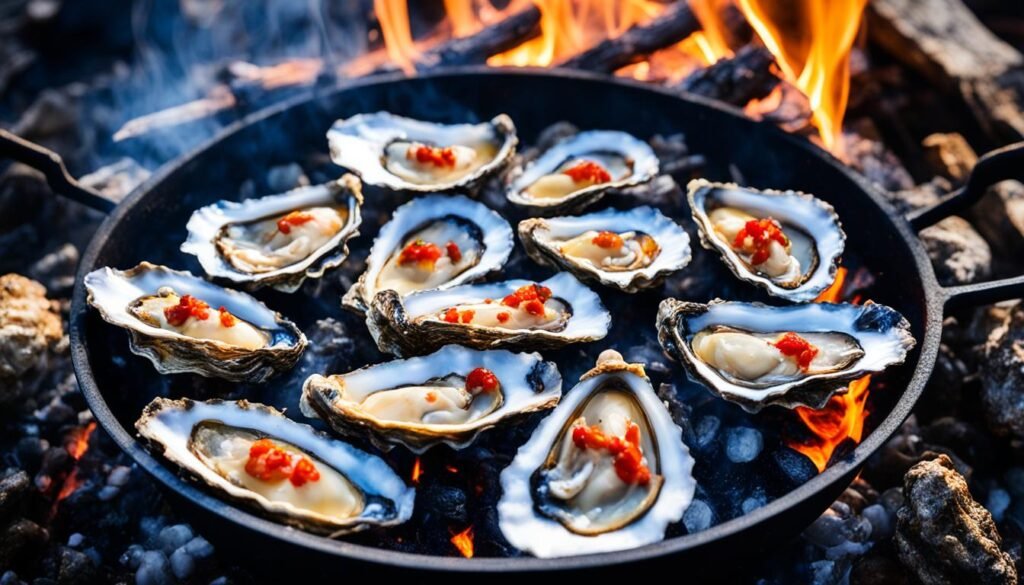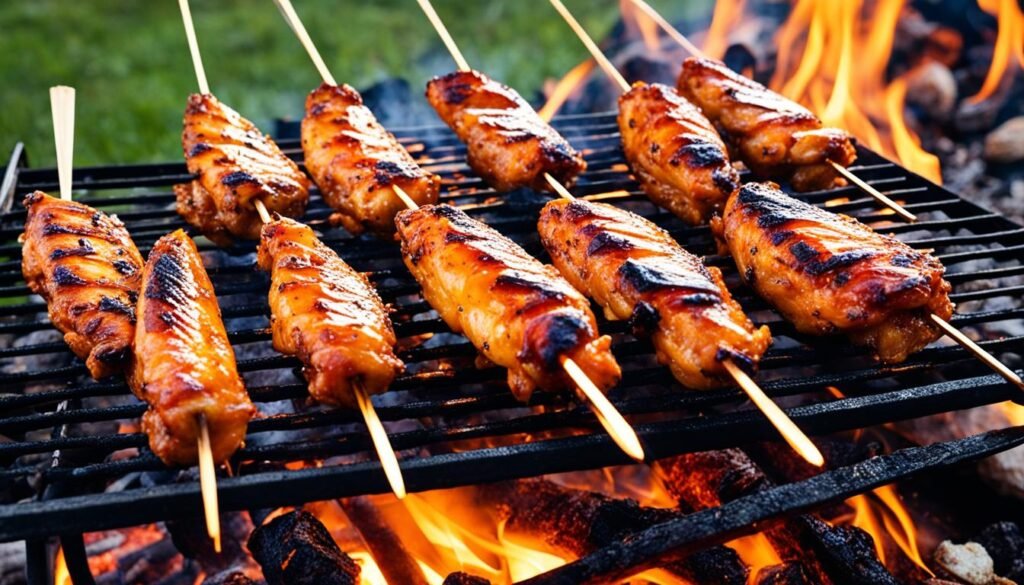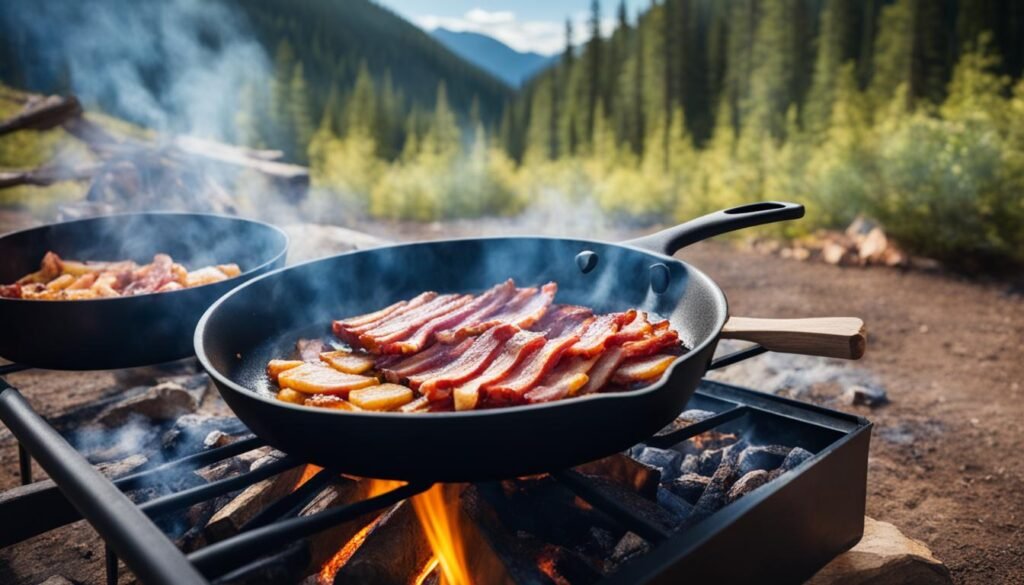As an avid culinary enthusiast, I’ve always been drawn to the timeless allure of open fire cooking. It invokes a sense of primal satisfaction, and among the myriad of delicacies that can be transformed by this method, oysters stand out for their ability to absorb the essence of the smoke and embers. Today, I’d like to share my experience and guide you on how to cook oysters on a campfire, an outdoor cooking technique that echoes the heritage of coastal cuisine while delivering an exquisite merger of sea and smoke.
Campfire seafood recipes often celebrate the natural flavors of the ocean, but few do it quite like oysters roasted over a crackling fire. They become a vehicle for the distinctive ‘merroir,’ a term that references their unique taste influenced by the waters where they were harvested, complemented by the impactful smokiness that only open flame can impart. Let me walk you through the fulfilling process of creating this campfire specialty that can be a highlight of any seaside gathering or outdoor excursion.
Key Takeaways
- Discover the transformative flavor oysters gain from being cooked on a campfire.
- Embrace traditional outdoor cooking techniques that enhance the natural ‘merroir’ of oysters.
- Learn the simplicity and satisfaction of preparing classic campfire seafood recipes.
- Experience the rich heritage that comes with mastering how to cook oysters over an open fire.
- Appreciate the smokiness infused into oysters, elevating them beyond their already delectable raw state.
- Find joy in sharing a culinary technique that connects us to early American settlers and Native American traditions.
The Historical Roots of Cooking Oysters over Open Flames
My journey through the world of campfire cooking led me to the rich tradition of roasting oysters over an open flame. This culinary practice, brimming with historical significance, provides not only a delectable taste experience but also a connection to the past. Understanding the historical context of campfire oyster recipes enriches the experience, blending campfire cooking tips with a narrative of our ancestors.
Learning from Native Americans and Early Settlers
Exploring the roots of campfire-roasted oysters, I found that the technique was originally gleaned from Native Americans who held a profound knowledge of their local bounties. Early American settlers swiftly incorporated this method into their cooking repertoire, recognizing the ease with which these mollusks could be poached in their shells over a robust blaze. This simple yet profound practice translated not just the elements of heat and smoke, but also a culinary philosophy rooted in respect for natural resources and sustainable consumption.
The Rise of Roasted Oysters in American Coastal Cuisine
As American coastal cuisine began to develop, dishes such as fire-roasted oysters emerged as pillars of regional gastronomy. The practice of roasting oysters on a campfire was no longer just a sustenance technique; it had become an art form. Each oyster, with its merroir — akin to terroir in viticulture, enveloped in the definitive charred flavors of a wood blaze, became a testament to the harmony of sea and fire. Culinary adventurers and enthusiasts alike continue to be drawn to this heritage technique, craving the unique flavor profile that can only emerge from the embers of a well-tended campfire.

Now, as I share these insights with fellow food lovers and outdoor chefs, I look forward to imparting not just the ‘how-tos’ but also the historical significance behind each savory bite. Let us continue to carry the torch, or perhaps more fittingly, the glowing coals, of this age-old culinary tradition.
Gathering Your Ingredients and Tools for Campfire Oysters
Embarking on the preparation of oysters over an open flame is not only an exercise in outdoor culinary skills but also a nod to tradition and a tribute to the sea’s bounty. Much like any craft, the first step is assembling the essential elements; necessitating fresh ingredients and the appropriate tools. 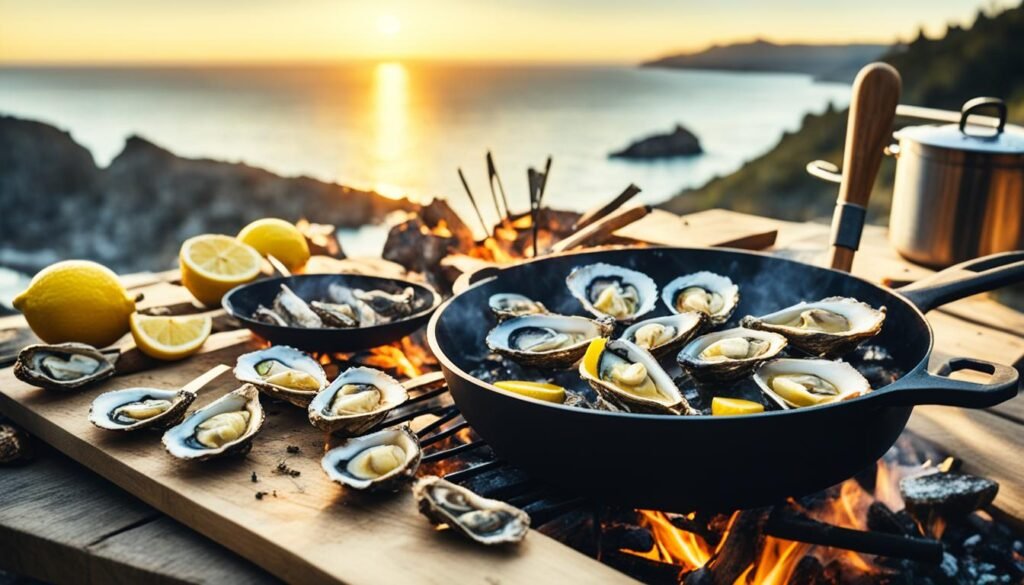
Choosing Fresh, Unopened Oysters
My pursuit of the finest shellfish recipes for camping leads me to local sources for oysters. It is here that I exercise care to select oysters that are unopened – a telltale sign of their freshness. A generous dozen sets the stage for our campfire culinary session, making certain that each oyster undergoes a thorough rinse to strip away all traces of dirt and grit.
Preparing Wood or Charcoal for Your Campfire
With the oysters prepared, my attention shifts to the fire that will transform them. A blend of oak and hickory serves as the perfect foundation for a fire that radiates intense heat yet spares us from excessive smoke. On a grill or nestled in a fire pit, these woods become the pillars upon which the aromatic spectacle of making oysters over flames is built. The key lies in patience; a robust fire must be allowed to reach its zenith of heat before the oysters can be introduced to the incandescent coals.
Once achieved, a single layer arraignment of oysters on a metal rack ensures an even cooking process. Watching these sea jewels submit to the flames’ embrace, where they will soon reveal their oceanic flavors enhanced by smoky whispers, defines the very essence of campfire gastronomy.
How to Cook Oysters on a Campfire
As I approach the heart of my outdoor cooking techniques, the campfire blazes, ready to transform simple oysters into a campfire seafood feast. Today, I’ll provide a detailed guide on how to leverage the fierce, white hot coals to steam and poach oysters to perfection, infusing them with the smoky zest that only an open flame can bestow.
With the flames dancing and embers glowing, anticipation builds for the oyster indulgence that awaits. My experience teaches that timing is critical; the moment the campfire is primed will dictate the culinary art that ensues. Within approximately 3-5 minutes of exposure to the high heat, the oysters’ shells will perform their telling dance, starting to pop open, signaling they’ve been poached to perfection.
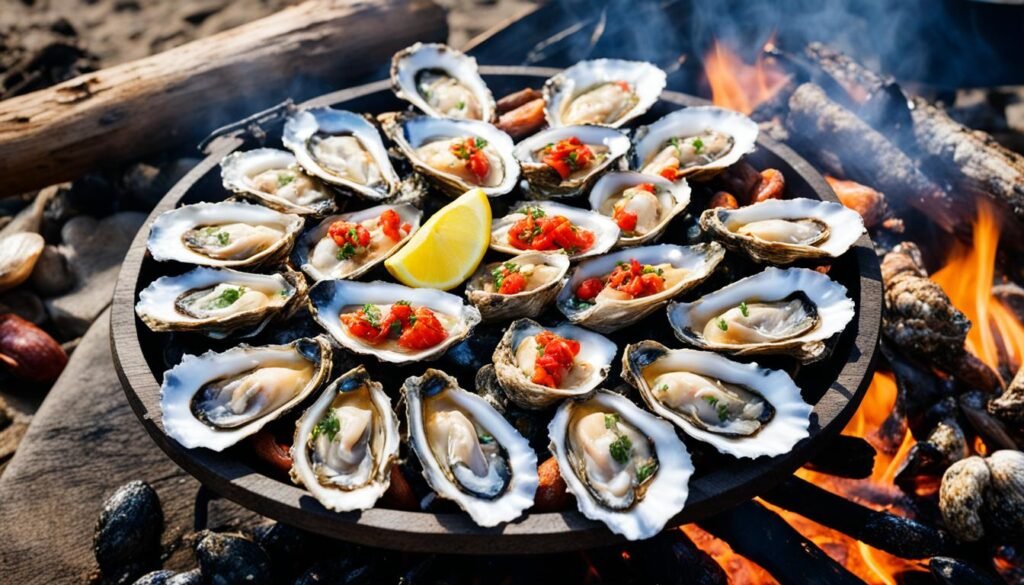
Maneuvering to remove the oysters requires both attention and care. Protecting my hands with gloves or an oven mitt, I gently but firmly wield the oyster knife to pry the stubborn shells apart, rewarding me with the succulent treat inside. The next step is presenting these campfire-kissed gems on a plate, pairing them beautifully with a dressing of my choice—a tradition that magnifies the joy of this culinary expedition.
Remember, whether you choose to elegantly fork them or heartily slurp them right from their shells, the manner of savoring campfire-cooked oysters is a personal reverie to be embraced.
- Wait for the campfire to reach optimal heat with white hot coals.
- Place the oysters over the heat for 3-5 minutes.
- Watch for the shells to begin popping open, indicating readiness.
- Carefully remove the oysters using protection for your hands.
- Pry open the shells with an oyster knife and ready them for serving.
- Plate your oysters and complement them with a dressing of your liking.
In embracing these outdoor cooking techniques, you not only craft divine campfire seafood recipes but also partake in an edible narrative, one that transcends time—connecting you to the primal shores of history where fire was the first kitchen and oysters, the primordial feast.
Mastering the Technique of Oyster Shucking
For enthusiasts of outdoor culinary skills, mastering the technique of oyster shucking is a quintessential aspect of campfire cooking. Beneath the smooth shells lie the briny delicacies that are a favorite among gourmets around the campfire. Here, I’ll dive into the nuances of shucking oysters safely, ensuring you’re equipped with the proper tools and techniques for your next outdoor feast.
Tools You’ll Need for Shucking Oysters Safely
Before embarking on shucking, it’s imperative to arm oneself with the right tools. The essential arsenal consists of an oyster knife, known for its specialized blade for prying open oyster shells, and a set of durable gloves to protect your hands from cuts. These two tools form the foundation of a safe and enjoyable shucking experience, contributing to effective campfire cooking tips.
Step-by-Step Guide to Shucking Like a Pro
Shucking an oyster is akin to unlocking a treasure chest – it requires finesse and understanding of the shell’s anatomy. To shuck like a pro, follow these streamlined steps and revel in the satisfaction of revealing the succulent morsels within:
- Chill Your Oysters: Place your oysters on a bed of ice until they’re ready for the grill. The chill relaxes the oyster muscles, facilitating easier opening.
- Protect Your Hands: Don a pair of gloves to ward off any accidental slips of the knife that might lead to injury.
- Identify the Hinge: Locate the hinge at the oyster’s pointed end where the two shells meet; this is your entry point for the knife.
- Insert the Knife: With gentle pressure, insert the blade of your oyster knife into the hinge. Give a subtle twist to pry the shells apart.
- Sever the Muscle: Slide the knife along the inside of the upper shell to cut the muscle that binds the oyster, keeping the knife close to the shell to avoid damaging the oyster.
- Clean and Inspect: Remove any shell fragments and inspect the oyster to ensure it’s clean and ready for preparation – a vital step in your outdoor culinary skills repertoire.
With these steps in your grilling arsenal, you’ll not only bask in the glory of perfectly shucked oysters but also in the enhancement of your campfire cooking tips. Whether you’re an aficionado or a novice in the art of campfire cuisine, the joy derived from shucking is second only to the pleasure of tasting these fire-grilled delicacies.
And now, let us proceed to the heart of the matter—the savory, smoke-infused oysters that await their moment over the coals. The skillful shucking is merely the opening act to the culinary ballet that culminates in a feast by the fire.
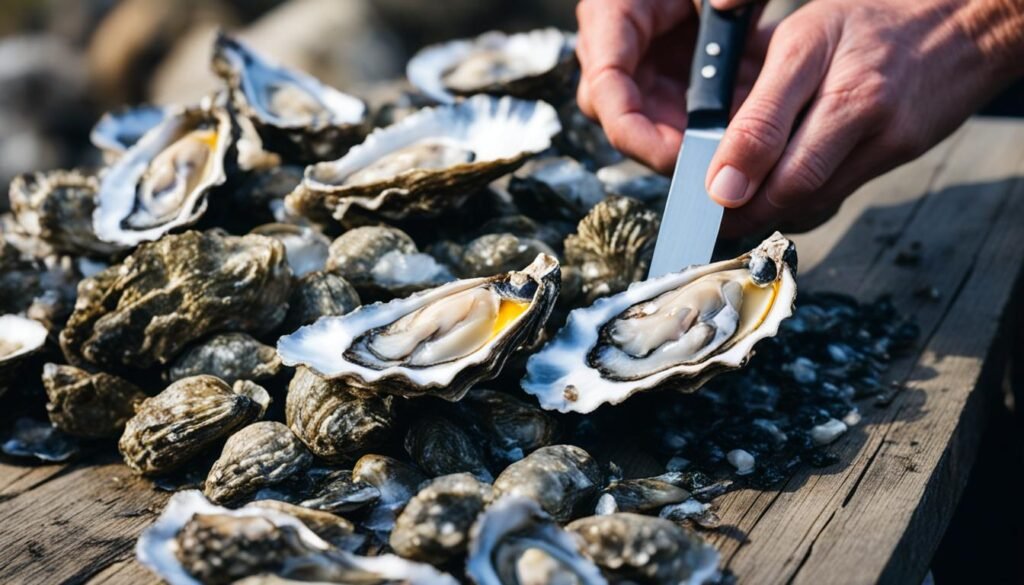
Creative Campfire Oyster Recipes to Try
There’s nothing quite like the combination of oysters and an open flame to excite the palate of any seafood enthusiast. Combining the delicate flavors of oysters with the smokiness of a campfire is a culinary adventure worth exploring. Below are two irresistible shellfish recipes for camping that will enhance your outdoor dining experience.
Garlic and Herb Butter Oysters on the Coals
Introducing a campfire oyster recipes classic: Oysters luxuriating in a pool of garlic herb butter, cooked to perfection over white hot coals. This recipe is simple to prepare and relies on the quality of ingredients and the smoldering embers of your campfire.
- Shuck your oysters and keep them chilled on ice
- Prepare your campfire using Cowboy Hardwood Lump Charcoal, known for its clean burn
- Combine melted butter, finely chopped parsley, grated Parmesan cheese, a touch of garlic powder, a pinch of black pepper, and a dash of hot sauce for a kick
- Spoon the butter mixture into the oyster shells filled with their natural liquor
- Set the oysters directly on the hot coals for 3-4 minutes
- Watch as they cook quickly; use heat-resistant gloves to avoid burns
- Finish with a sprinkle of parsley and Parmesan, and let them cool slightly before serving
Enjoy the distinct campfire flavor complemented by the smooth, herbaceous taste of garlic and parsley.
Parmesan-Parsley Oyster Delight
Perfect for those who adore the inherent flavors of the sea, the Parmesan-Parsley Oyster Delight showcases the oyster’s natural taste with subtle enhancements from select herbs and spices.
- Start with freshly shucked oysters resting on a bed of ice
- Create a compound butter with unsalted butter, minced green garlic or scallion, chopped chives and thyme, crushed red pepper, lemon juice, and a hint of pastis
- Chill the butter mixture until firm
- Top each oyster with a slice of the flavored butter
- Grill over your campfire until you see the oysters’ juices bubbling
- Once the butter has melted and the oysters are cooked, they’re ready to be savored
The combination of fiery heat with the cooling touch of herb butter creates a campfire delicacy unlike any other.
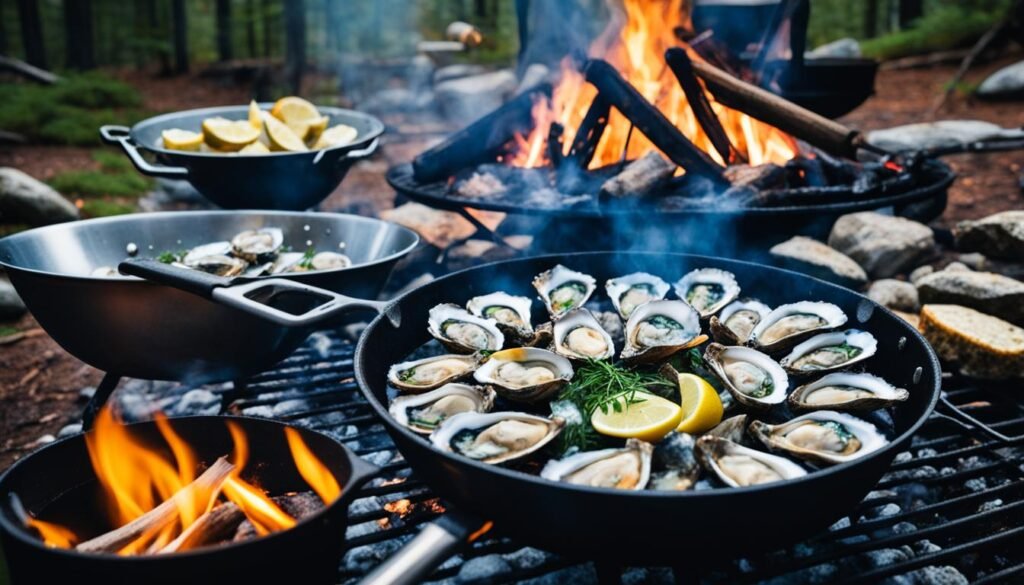
Oysters are more than just seafood; they’re a canvas for bold campfire culinary exploits. With these recipes, you usher in flavors that pay homage to traditional techniques while inviting innovation. Whether you’re an aficionado or experimenting with shellfish recipes for camping for the first time, these campfire oyster dishes are a surefire way to dazzle your senses and those of your fellow campers.
Enhancing Oysters with the Right Seasonings
Upon the open flames of a campfire, the elemental dance of fire and oysters unfolds, a culinary harmony enriched by the careful selection of seasonings. As you seek out the subtleties of how to cook oysters on a campfire, understand that the smoky flavor imparted by the embers is but a foundation, one that is elevated by the vibrant accents of fresh herbs and robust condiments.
The Importance of Parsley, Garlic, and Parmesan
The interplay of parsley, garlic, and Parmesan is not accidental; it’s a deliberate blend that enhances the marine splendor of oysters with an aromatic bouquet. Parsley imparts a refreshing and subtle bite, garlic introduces a pungent earthy depth, and the Parmesan rounds out the trio with a savory, umami-rich caress. Together, they forge a trio that enlivens the innate flavors of charred oysters, elevating them beyond their sea-born simplicity.
Experimenting with Spices and Sauces for Your Perfect Recipe
Adventure lies at the heart of campfire cooking tips, urging you to delve beyond the tried and true. The canvas of smoke-laced oysters welcomes the addition of a peppery kick from freshly ground black pepper or the capricious zing of a carefully measured dash of hot sauce. The journey of taste you embark upon need not be confined to the traditional; it should mirror the rhythm of your personal palate.
And so, let me share with you a quick guide, a harbinger of flavors to come, showcasing both tradition and innovation:
- A sprinkle of sea salt awakens the ocean essence within the oysters.
- An infusion of cracked black pepper adds a gentle yet insistent spice.
- The verdant zest of parsley, finely chopped, weaves a fresh complexity into the smoky notes.
- Melted butter carrying the warm tone of garlic, setting the stage for a silken finish.
- A generous dusting of grated Parmesan cheese, melting into the concoction, to create a rich textural contrast.
- A careful dose of hot sauce, for the brave at heart, to introduce an exhilarating heat that punctuates each bite.
In your quest to master how to cook oysters on a campfire, these seasonings are your allies, your artistic tools in crafting the ultimate open-flame delicacy. Whether you stand beneath the open sky or beside the roaring waves, this venture is a testament to the alchemy that occurs when seasoning meets seafood before the amber glow of a campfire.
Outdoor Cooking Techniques for Shellfish Perfection
Exploring the realm of outdoor cooking techniques, particularly for shellfish such as oysters, unveils a world where heat, timing, and safety converge to create sublime campfire seafood recipes. The unique challenge of cooking over an open flame transforms the simple act of grilling into a culinary art where both skill and passion are entwined with each ember.
The Benefits of High Heat and Quick Cooking Times
As I delve into these practices, I am reminded that achieving shellfish perfection hinges on the mastery of high heat and quick cooking times. This combination ensures a delightful sear that not only preserves the delicate oyster juices but enhances their oceanic flavor with a delectable smoky undertone. A swift roast over white-hot coals transforms the once briny bivalves into succulent treats with a tantalizing char—a true testament to the effectiveness of precise campfire culinary execution.
Safety Tips for Campfire Seafood Cooking
While indulging in the art of cooking oysters over a campfire elicits immense gourmet satisfaction, I am constantly mindful of safety precautions. The use of heat-resistant gloves is essential in avoiding painful burns as I place and retrieve oysters from the searing embers. Furthermore, the propensity of butter to cause flare-ups necessitates an ever-watchful eye to prevent these sudden bursts of flame from overshadowing the grilling experience. By adhering to these safety measures, I ensure that my outdoor cooking endeavors remain a source of pleasure devoid of danger, allowing the full focus to rest on crafting those mouth-watering campfire specialties.
Tailoring Your Campfire Setup for Optimal Oyster Roasting
When the allure of the outdoors beckons, and the craving for ocean-fresh oysters becomes undeniable, knowing how to cook oysters on a campfire becomes an invaluable skill. It’s in these moments, beneath the open sky, that I prepare my campfire with great care, ensuring each element is poised to produce the perfect sear over the flames. Experience has taught me that the success of making oysters over flames hinges not just on the freshness of the seafood but equally on the quality of the charcoal and the precision of the cooking environment.
Achieving High Temperatures with the Right Charcoal
Through countless campfire cookouts, I’ve come to rely on Cowboy Hardwood Lump Charcoal. Its ability to reach and maintain white-hot temperatures is indispensable for roasting oysters to that perfect point. High-quality charcoal like this is essential as it burns cleaner and hotter, allowing me to achieve those high temperatures necessary for a swift and savory roast without the worry of chemical flavors infiltrating the delicate taste of the oysters.
Grill Placement and Coal Management for Even Cooking
Managing the grill placement and the coal arrangement is akin to conducting an orchestra; each movement and each piece contributes to the symphony of flavors. It begins by letting the fire burn for 10-15 minutes. Once the coals glow white-hot, I push them into a flat pile—creating an even cooking surface is crucial for the oysters to roast uniformly.
Here’s how I align my setup for consistent results:
| Preparation | Execution | Outcome |
|---|---|---|
| Allow the Cowboy Hardwood Lump Charcoal to burn until white-hot. | Place oysters directly on the grill over the most intense heat. | Oysters cook quickly and evenly, and the shells pop open when ready. |
| Arrange the coals in a flat, even layer for uniform heat distribution. | Monitor the oysters, looking for the slight opening of shells. | Minimize under or over-cooking, ensuring tender, perfectly roasted oysters. |
| Prepare a secondary cooler zone on the grill for oysters that open early. | Move oysters to the cooler area if they are at risk of overcooking. | Preserves the nuanced flavors and textures of each oyster. |
Adhering to these established outdoor culinary practices enhances not only the flavors but also the overall experience, turning the simple act of roasting oysters on a campfire into a culinary event that’s both deeply satisfying and steeped in tradition.
Pairing Your Smoky Oysters with the Right Sides and Drinks
The crescendo of a campfire culinary experience with oysters is not just about mastering outdoor culinary skills for that smoky perfection, but also about the thoughtful pairing with sides and beverages that complete the gastronomic tableau. As an enthusiast for campfire oyster recipes, I believe that the accompaniments serve as the stage upon which these marine delicacies shine, with contrasts and complements that accentuate each smoldering, savory bite.
Complementing Flavors for a Full Campfire Feast
When I consider sides for oysters, my focus is on freshness and texture to balance the smokiness. A crisp salad, tossed lightly in a lemon vinaigrette, adds a refreshing crunch and bright acidity. For something heartier, crusty bread proves an excellent choice, ideal for sopping up the delicious oyster juices and buttery residue that linger on the plate. These simple, yet thoughtful selections add layers to your feast, elevating each grilled oyster from mere appetizer to a harmonious part of a full campfire meal.
Selecting Beverages to Enhance the Oceanside Experience
Pairing drinks is equally strategic; it’s about echoing and enhancing the oysters’ flavors. Alcohol, with its own nuanced profiles, can profoundly influence the taste of seafood. A cold beer, specifically one with a crisp finish, cuts through the rich, smoky flavors with a palate-cleansing effect. When it comes to wine, a chilled glass of Sauvignon Blanc, with its acidity and citrus notes, provides an impeccable counterpoint to the briny depth of each oyster. These beverage selections are the final brushstrokes in the art of campfire dining, ensuring a refreshing balance to complement the palate and echoing the very ambience of seaside repasts.
FAQ
What do I need to cook oysters on a campfire?
To cook oysters on a campfire, you’ll need fresh, unshelled oysters, a heat source (wood or charcoal), a fireproof surface or grill over the fire, oyster shucking tools (knife and gloves), and any desired seasonings or sauces for flavor.
How do I choose the best oysters for campfire cooking?
Select fresh oysters with tightly closed shells from a reputed fish market. Make sure they’re clean and free of mud. Store them on ice until it’s time to cook.
What type of wood or charcoal should I use for the campfire?
Hardwoods like oak and hickory are ideal for campfires as they produce intense heat and minimal smoke. For charcoal, choose a high-quality product like Cowboy Hardwood Lump Charcoal for clean, high-temperature cooking.
Can you give me a step-by-step guide on how to cook oysters on a campfire?
Start with a well-established fire with white hot coals. Place the oysters on the grill or fireproof surface in a single layer. Once the shells begin to open (approx. 3-5 minutes), remove them from the fire, shuck the oysters with an oyster knife, and serve with desired accompaniments.
What are some campfire oyster recipes I can try?
A popular recipe is Garlic and Herb Butter Oysters, where you place shucked oysters over the coals and top them with a mix of butter, herbs, and seasonings. Another is Parmesan-Parsley Oyster Delight, which recommends adding a mix of butter, minced herbs, and cheese before grilling.
What are the recommended seasonings for campfire oysters?
Enhance the smoky flavor of oysters with hearty seasonings like parsley, garlic, and Parmesan. Feel free to experiment with other spices, hot sauce, or lemon for a personalized taste.
What are some important outdoor cooking techniques for shellfish?
Use high heat and cook quickly to sear the shellfish and lock in flavor. Always watch for flare-ups and use heat-resistant gloves to handle hot shells for both good results and safety.
How do I shuck oysters safely and efficiently?
Use an oyster knife and gloves to protect your hands. Place the oyster level on ice to stabilize it, insert the knife near the hinge, twist to open, then run the knife along the top shell to free the muscle, and clear any debris before cooking.
How can I ensure even cooking when roasting oysters on a campfire?
Achieve even cooking by managing the placement of your grill and arranging coals properly. Allow the fire to reach a consistent temperature (about 10-15 minutes) before placing the oysters over the heat.
What drinks and sides pair well with smoky campfire oysters?
Fresh salads or crusty bread complement campfire oysters nicely. Pair them with a crisp, cold beer or a white wine like Sauvignon Blanc to balance the richness of the oysters.

